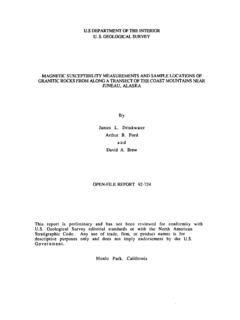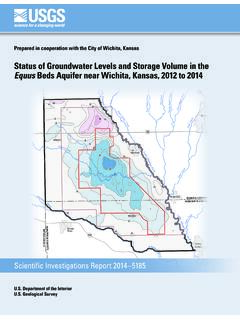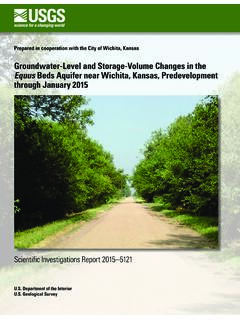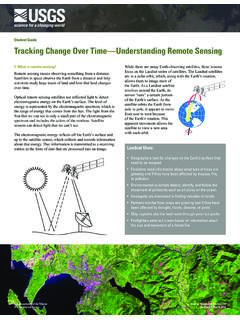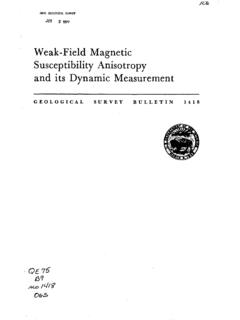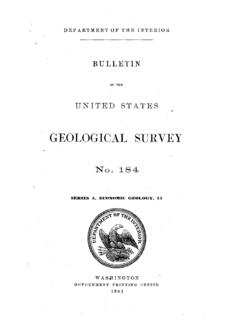Transcription of Investigating the Environmental Effects of Agriculture ...
1 GrasslandsWetlandsUrbanExplanationForest ShrublandAgriculturalWaterOtherInvestiga ting the Environmental Effects of Agriculture Practices on Natural ResourcesScientific Contributions of the Geological Survey to Enhancethe Management of Agricultural LandscapesLand cover map of the conterminous United States from early 1990s data (Vogelmann and others, 2001; Nakagaki and Wolock, 2005).Printed on recycled department of the Geological SurveyFact Sheet 2007 3001 January 2007 Geological Survey (USGS) enhances and protects the quality of life in the United States by advancing scientific knowl-edge to facilitate effective management of hydrologic, biologic, and geologic resources ( ).
2 Results of selected USGS research and monitoring projects in agricultural landscapes are presented in this Fact Sheet. Significant Environmental and social issues associated with agricultural production include changes in the hydrologic cycle; introduction of toxic chemicals, nutrients, and pathogens; reduction and alteration of wildlife habitats; and invasive species. Understanding Environmental consequences of agricultural production is critical to minimize unintended Environmental conse-quences. The preservation and enhancement of our natural resources can be achieved by measuring the success of improved management practices and by adjusting conservation policies as needed to ensure long-term protection.
3 Interdisciplinary USGS research and monitoring plays a key role in providing independent scientific information needed for the understanding, management, and mitigation of short- and long-term Effects of agricultural practices on natural and human resources. USGS scientific information is used by a variety of stakeholders that include public, private, and special-interest groups, agricultural producers, and State, Tribal, and Federal governments that manage the Nation s natural resources. Effects of land use change and habitat fragmentation on conflicting urban and agricultural water of air and ground-water and surface-water interactions on water of agricultural drainage, irrigation, and return flow on water and implementation of innovative farming techniques to conserve soil and water and to improve water of genetically modified organisms on native species and for identifying sources of agricultural contamination and rapid assessment of pesticides, nutrients.
4 And sediments on fish and wildlife health and habitat of watershed characteristics soils, riparian forests, and wet-lands Effects on nutrient uptake, retention, and and fate of endocrine disrupting compounds, veterinary antibiotics, feed additives, hormones, and pathogens in terrestrial and aquatic ecosystems. Over half of the land in the Nation s lower 48 States is in crops, pasture, and range (Lubowski and others, 2006). By 2004, half of the original wetlands in the lower 48 states was converted to mostly agricultural uses (Claassen, 2004). From the start of European settlement until 1954, about 42 percent of original wet-lands were drained and filled and used for settlement and agricul-ture.
5 From 1954 to 1974, wetland loss was reduced by half (Wiebe and Golleron, 2006). Nearly all of the pre-settlement forest, prai-rie, and wetland areas in the Midwestern and Great Plains States have been converted to or affected by agricultural advances in agricultural production methods over the past 60 years have dramatically changed the character of Agriculture . The number of farms declined from million in 1935 to million in 2002. Whereas small family-owned farms once produced the majority of the Nation s agricultural products, in 2003 small farms accounted for 91 percent of farms, but only 27 percent of total agricultural production.
6 By 2002, half of the farm sales came from 2 percent of farms and 11 percent of the land in farms (Wiebe and Golleron, 2006). Support of this intensi-fied Agriculture requires larger fields, reduction in the types and rotations of crops, and greater reliance on agrichemicals (nitrogen, phosphorus, pesticides) to maintain high productivity. Significant Environmental and social issues associated with agricultural production include changes in the hydrologic cycle; introduction of toxic chemicals, nutrients, and pathogens; reduction and alteration of wildlife habitats; and invasive species.
7 Under-standing Environmental consequences of agricultural production is critical to minimize unintended Environmental consequences. The preservation and enhancement of our natural resources can be achieved by measuring the success of improved management practices and by adjusting conservation policies as needed to ensure long-term protection. Science Issues and Needs Identified by the USGS, as Related to Environmental Impacts of Agricultural PracticesThePUMPEDWELLRECHARGEAREAS treamDISCHARGEAREADaysYearsYearsDaysCent uriesMillenniaConfiningbedConfiningbedCo nfinedaquiferUnconfinedaquiferConfinedaq uiferWatertableMovement of Agricultural Chemicals Through the Hydrologic SystemThe key to understanding and managing Effects of agricul-ture-associated chemicals, bacteria, and pathogens involves trac-ing the movement of compounds from where they are applied, knowing their persistence in the environment.
8 Measuring their transport and fate, and measuring their bioavailability and potential Effects on humans and wildlife. Transport by air and water-soil mixtures are the two primary ways for compounds to travel from agricultural lands into surrounding environments. Effects of agricultural chemicals can vary widely depending on local topography, hydrology, soils, geology, and the rate and timing of applications relative to precipitation. The USGS studies the movement of agricultural chemicals in the entire hydrologic cycle. Many studies of the behavior of chemicals applied to crops and soils have focused on crop uptake, soil quality, and surface runoff, and do not include the movement of these chemicals in the atmosphere, below the root zone, through the unsaturated zone, into ground water, and eventually into streams.
9 USGS studies have shown that water-sheds with large ground-water inflows generally respond more slowly to changes in chemical application rates than water-sheds dominated by surface-water inflows (Bohlke, 2002). Tile drainage intercepts downward flow, or recharge, and delivers it quickly to streams, reducing the potential for nutrient reduc-tion. Understanding the interaction of these processes is key to understanding associated movement of natural and agricultural chemicals. The amounts of chemicals transported can vary by several orders of magnitude due to fluctuations in precipitation, streamflow, and ground-water movement.
10 It can be difficult to predict or measure the response of a watershed to changes in management if the watershed response to those changes is equal to or less than changes caused by natural variability. Under-standing the hydrologic setting and its controlling variables can improve the design and efficiency of monitoring programs and models that measure or estimate watershed response to changes in management concentrations in streams and shallow ground water within agricultural areas are often elevated due to multi-year inputs of nutrients from fertilizers and manure ( Geo-logical Survey, 1999).
